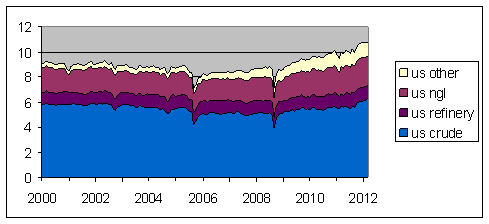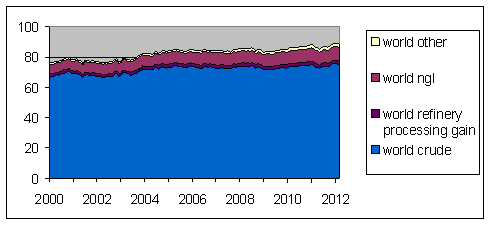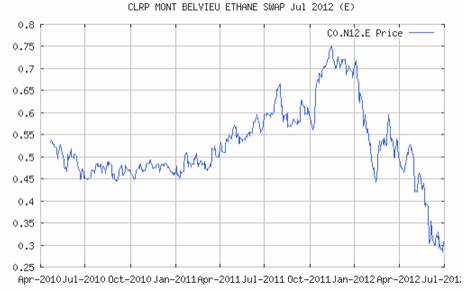According to the Energy Information Administration, in March the United States produced a “total oil supply” of 10.8 million barrels per day, which was 2.1 mb/d more than in January 2005. But if you just rely on those aggregate numbers, you’ll miss some very important trends.
The EIA’s definition of total oil supply represents the sum of a number of different components. The core is field production of crude oil and lease condensates, the latter being hydrocarbons that are a gas at reservoir temperatures and pressures but that can be separated into liquids at wellhead surface facilities. This core production is represented by the blue region in the graph below. Another category is the refinery processing gain, which results from the fact that the refined products occupy a larger volume than the original crude oil. These two components represented about 3/4 of the total in 2005, but account for only 40% of the 2.1 mb/d increase in the U.S. total supply figure since 2005. A bigger factor in the U.S. increase since 2005 has been natural gas plant liquids (hydrocarbons with a higher energy content than methane which can be separated out from methane at natural gas processing facilities) and other liquids (chiefly biofuels).
 |
Natural gas liquids and biofuels historically were a less significant factor in the global oil supply, contributing only 10% to the 2005 total. But they account for almost half of the increase in world production since then.
 |
The figure below breaks the U.S. NGL numbers down into specific components. A molecule of ethane has 2 carbon atoms, compared to only one for methane, the basic component in pure natural gas. Although ethane has a higher boiling point and more energy than methane, you’d still have to bring ethane down to a Fahrenheit temperature of 127 degrees below zero to make it a liquid. You can’t drive your car with ethane, and it’s currently almost exclusively used to make ethylene for the chemical industry. The next in molecule size is propane, with 3-carbon molecules and a boiling point of -43o F. Propane potentially could be used as a transportation fuel, but is currently used primarily for heating and petrochemicals. Ethane and propane between them account for 82% of the increase in U.S. NGL production since 2005.
 |
Just as the success in producing natural gas in the U.S. has created a huge price differential between crude oil and methane on a BTU basis, the natural-gas byproduct ethane has also now started to tumble in price. That’s important because NGLs have been a key byproduct sustaining the feasibility of natural gas production given the low prices for methane itself. The Wall Street Journal reported last week:
Energy producers struggling with decade-low natural-gas prices have been relying on related fuels such as ethane, propane and butane to remain profitable.
But so many companies have increased drilling of wells with the fuels, known as natural-gas liquids, that their prices are falling as well, creating a new supply-glut problem for the industry and threatening to crimp profits….
Natural-gas liquids revenue last year was about $42 billion, close to natural-gas revenue, which was about $48 billion, according to Tudor Pickering Holt & Co. estimates….
Ethane at the Mont Belvieu, Texas trading hub, a traditional pricing benchmark, sold for 28.4 cents per gallon Tuesday, down from a peak average of 89 cents in October, according to Platts research. Propane at Mont Belvieu sold for 79.65 cents per gallon, down from $1.47 a gallon in October….
No major companies have stopped drilling for natural-gas liquids altogether, but Occidental Petroleum Corp (OXY) Chief Executive Stephen Chazen recently warned that the drop in prices was “troubling” and approaching levels where further production at those rates may not be economically viable.
“If the current low NGL prices continue, cutbacks in liquids-rich wells or gas-rich wells may be necessary,” Mr. Chazen said in a call last month.
 |
The bottom line is that it doesn’t make sense to think of NGLs as something that you can simply add to traditional crude oil production, either if you’re trying to evaluate the supply and demand situation for oil and gasoline, or if you’re contemplating a personal investment in the stock of a particular oil- or gas-producing company.
U.S. petrochemical companies seem one likely beneficiary of these trends. Drivers of conventional U.S. cars, not so much.
Automotive manufacturers have attempted for decades to get CNG vehicles accepted, but previously high costs for natural gas and high conversion costs/low volumes have been discouraging.
It is reasonable that the primary market for CNG vehicles is fleets. http://www.anga.us/media-room/blog/2012/6/26/shell-fuels-growth-for-natural-gas-truck-fleets-with-more-refueling-stations
Presuming NG costs remain relatively low, more fleets will adopt these vehicles and more fueling locations will become available. This could lead to consumer choices in urban areas, again presuming that purchase/operating costs are equal to or lower than conventional gasoline powered vehicles and much lower than pure electric vehicles and their very limited range.
Any possibility of widespread movement to NG powered vehicles is decades off.
Nice, clear straight-forward exposition. I wish we had more of this, not only in oil and gas, but economics more generally.
There’s a bit more color to the story. For petrochemicals production, refineries can run on either oil or some natural gas liquids. However, if I understand correctly, a petrochemcial facility will be set up to run on either oil-based or nat-gas based products and cannot shift between them at will.
Thus, over the long run, there appears some substitutability between gas and oil in petrochemicals processing, but much less in the short run.
There are more than a million CNG powered vehicle in India.
The Delhi Transport Corporation currently operates the world’s largest fleet of CNG buses for public transport. http://www.product-life.org/en/archive/cng-delhi
Bruce Hall: “Any possibility of widespread movement to NG powered vehicles is decades off.”
Had the Republicans not filibustered the 2011 Natural Gas Act, it would have been less than 5 years.
Today in our area, PBS aired an energy program on which a consultant said that natural gas could be manufactured into methanol for use In vehicles and that the cost for manufacturers to allow this fuel to be used is about $100 per vehicle, much less than converting to natural gas.
Steven, technology is available to produce Ethylene from either Naptha or Ethane, the difference is in the cracking furnace design. There are mixed feed crackers existing and being built today.
Sandy –
Does that mean a petrochem plant can use either Naptha or Ethane, or only one or the other? How fungible are these things?
US annual crude oil (Crude + Condensate) production was 9.4 mbpd in 1970, and total liquids production was 11.7 mbpd. So, crude oil accounted for 80% of the US total liquids supply in 1970 (EIA).
US annual crude oil production in 2011 was 5.7 mbpd (up from the 2004 5.4 mbpd rate that we saw prior to the hurricanes), and total liquids production was 10.1 mbpd. So, crude oil accounted for 56% of the US total liquids supply in 2011.
Of course, we have seen no material increase in global annual crude oil production for six straight years, with a material and ongoing decline in global net exports oil, despite the fact that annual Brent crude oil prices doubled from $55 in 2005 to $111 in 2011.
Steven,
One can either crack Ethane or Naptha to produce Ethylene. The Cracking Furnace is designed accordingly. In case of a mixed feed cracker, you’d have multiple separate furnaces that can crack Ethane and Naptha simultaneously.
No these are not fungible, one cannot feed Naptha in an Ethane furnace or vice versa.
I’m not a ChemE, but I believe that most ethane produced by refineries ends up as fuel gas in furnaces.
Propane and butane can be blended into gasoline during the winter months, but is too volatile for summer gasoline.
You slightly miss spoke on this point “U.S. petrochemical companies seem one likely beneficiary of these trends. Drivers of conventional U.S. cars, not so much.” Propane is a primary heating fuel for a majority of rural homes across the country and trust me, they are appreciating the cheaper propane pricing.
Propane is a fuel commonly used in areas that are not on the natural gas pipeline network. In addition it has been possible for a long time to fuel cars with it, but just not economic. In a 1950s book I saw that tractors were often powered by it because the farmer already had a propane tank for house heating and cooking, so it was easier to fuel the tractor than having another tank for gasoline.
@Buzzcut, a propane-butane blend is commonly known as LPG or Liquified Petroleum Gas, used as heating and motor fuel.
So we have:
NGL – Natural Gas Liquids
CNG – Compressed Natural Gas
LPG – Liquified Petroleum Gas
LNG – Liquified Natural Gas
bmz:
Glad that the Republicans resisted yet another hare-brained government mandate. If natural gas is a better alternative than gasoline, it will find a market and expand from there. The idea of government picking winners and losers is repugnant.
Bruce –
Picking winners and losers is exactly what the Republicans didn’t like about the nat gas bill. I don’t know how many times I heard that Boone Pickens is a rent-seeker.
Having said that, government policy is decisive in the adoption of natural gas. Right now, the cost of CNG tanks are heavily influenced by EPA and DOT regs, neither of which envisioned the potential for wide-scale adoption of CNG as transportation fuel at the time they were promulgated.
Thus, CNG regs need to be right sized, meaning that i) CNG vehicles should not be materially more dangerous that gasoline powered ones, and ii) they should not be vastly more polluting. As you say, the govt should stop picking winners and losers–exactly what over-spec’d regs are doing right now.
Rural areas actually are fine for refueling. Every little town has a gas company that has been servicing farms with natural gas, propane whatever for decades. Back in the early 80’s I knew several people in the small rural town where I grew up that installed conversion kits on their pickups.
Gov’t should not get into this? Who are you kidding? Let’s not assume that the Obama administration is as stupid as Bush who backed ethanol for automobiles. That was pretty stupid, I agree. Was the government stupid in pushing the internet forward? That event created billions of dollars in wealth. I think that was pretty smart governement. Brazil, which has a huge amounts of sugar cane, is energy self-sufficient because they were smart enough to know to use an abundant cheap resource for automobile fuel. The issue is not govt. vs. no govt., it is stupid vs. smart government. With some small subsidies, like tax breaks for building natural gas filling stations, we could get the Middle East off of our throats and be energy self-sufficient. Don’t forget that part of the reason we have oil is because we helped the oil industry with tax breaks until they did not need it any more. Curtis
Curtis: ‘With some small subsidies, like tax breaks for building natural gas filling stations…”
There are plenty of investment tax credits and business expense credits that are generally available to all businesses. What we don’t need are more “special interest” tax credits or loan guarantees or mandates for $26/gallon fuel that make no economic sense… basically the government trying to remake the economy and the competitive balance.
Natural gas is cheap; if it can’t be attractive at current prices, it won’t be competitive at all. The technology for CNG vehicles has been around for decades. It just doesn’t measure up to the technology/cost of other powertrains. Make it better and it will sell better.
U.S. petrochemical companies seem one likely beneficiary of these trends.
Only if they do not build new facilities in the expectation that production is sustainable. The problem that the petrochemical companies face is that the ‘glut’ is only temporary. The fact is that tight oil and gas from shale formations is not very economic outside of a few core areas. In the absence of the Fed’s very easy money policies the shale bubble would have burst quite some time ago. But even with those policies in place there is a serious problem in keeping all of the balls up in the air. The producer balance sheets are showing a huge increase in debt and if we used the EURs suggested by the production data we would find that profit remains very elusive and will remain elusive even at much higher prices.
Vehicle LPG conversions are cheap and easy (my sister-in-law’s brother has one). Certifying that they meet smog requirements, not so much. LPG is the third most common vehicle fuel internationally.
Thank you for this straightforward article.
It’s true that the only beneficiaries are going to be the petrochemical industry, and only some of that. The majority of cracking complexes in the US already run ethane or ethane/propane. This is intensifying from the US’s shale boom and from the middle east’s preference for E/P as a feedstock over naphtha. This has caused a couple of things to go on downstream. Ethylene is far more likely to come out of E or E/P crackers than propylene, so ethylene and propylene prices have become decoupled. Ethylene is now cheaper than propylene by a wide margin, historically speaking. Because of the relative decline in naphtha crackers and the shutdown of unprofitable naphtha crackers (no longer able to compete based on expensive feedstock), heavy olefin molecules that result from cracking naphtha, particularly butadiene and isobutene that are essential for the synthetic rubber industry, are now in shortage.
Either way, NGLs are going to see a few new crackers built in the US, but they aren’t going to fuel our cars. Not that it will stop hardline energy bulls from trumpeting the triumph of American production.